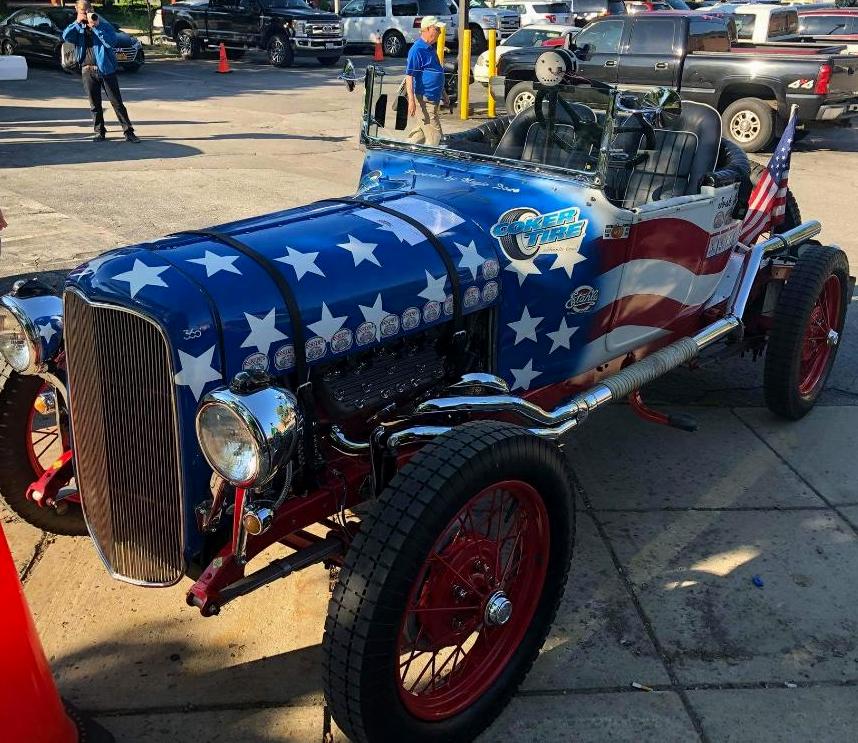
For all of the antique car enthusiasts, the world’s premiere old car rally, The Great Race, is underway! Josh Hull and Trevor Stahl will be driving the “Stars and Stripes” again this year. They are hopeful for a grand finish this time around.
Both gentlemen will be amongst 120 of the world’s most beautiful antique automobiles. The race started Saturday, June 23, in Buffalo, New York, and will finish on Sunday, July 1, for a total purse win of $150,000.
“Hull is one of our part-time paramedics here in Craig County,” said Jim Cady, Craig County Emergency Management and Services Coordinator. “Many of our EMS providers enjoyed following Josh with his cool looking American flag painted the car on a daily basis on social media.”
Hull lives in Botetourt and is a Roanoke City Paramedic. He started volunteering at age 17, went to college and was hired on to Roanoke City in 2007. He has worked part-time for Craig County for almost six years. “I wanted to be a firefighter since I was a kid,” Hull said.
“I am the owner of the ‘Stars and Stripes’ car as well as the navigator,” Stahl said before adding with a wink, “It’s also the most important position.”
Stahl currently lives in Montgomery County where he is the owner of Blacksburg Fit BodyBoot Camp. He got introduced to the race five-years ago when it traveled from Maine to Florida.
“His father has a pervasive car collection of a few hundred antiques which are highly collectible and rare,” Hull said. “I hopped in the backseat of my brothers 41′ Packard and road the rest of the way from Virginia to Florida with them to get the hang of it and learn the ropes. I was hooked instantly, and found a car to race the next year!”
The “Stars and Stripes” car is a 1932 Ford Dirt track Speedster with a 21-stud Flathead V8. However, the car has no top. Hull shared that one of the most common questions they get is, “What happens when it rains?” The response is always the same, “We get wet.”
Teams and cars from Japan, England, Germany, Canada and many parts in the state of New York will be participating in the event.
Said event director Jeff Stumb, “They will be spending five days in Buffalo before the start of the race getting ready for their nine-day, 2,300-mile adventure.”
Their route will include two-and-a-half days through the state of New York before zig-zagging around New England and then through New Brunswick and Prince Edward Island before finishing in Nova Scotia.
“It will be the first time the Great Race has ever taken place in the Atlantic Time Zone,” Stumb added.
The Great Race was created in the early 80s by Tom McRae, a car enthusiast by nature. His teammates shared he was also an enthusiast of life.
“McRae founded the race on the basis of honoring families, our great country and most importantly, God for making all things possible. He was diligent in saying a prayer in every city to bless the participants and everyone involved in each event as praising the Lord was a staple in his operation,” many of Tom’s friends have stated over the years.
Drivers are given their packet of instructions 30-minutes before each day’s race.
“It is truly not a map as it only gives you timed directions with turnoffs,” Hull said. “They do not tell you routes, only directions of how fast to drive and where to turn, such as to look for the first paved turn to the right with no road names.”
There are no calculators or cell phones allowed so this is where the expertise comes into play for each of the teams. A day of racing can be as little as four hours, but as many as ten.
Hull and Stahl both said that they do not get to do much scenery.
“I don’t really look at the road because my eyes are locked on the speedometer,” Hull said. “I have to keep the speedometer at the exact speed to complete that leg of the race and my navigator is busy calculating our exact speeds as we look for markers to turn.”
Because of this, Hull added that each driver has to know their car well, how fast their vehicle accelerates from 0 mph to 10, from 0-15mph as well as how fast it brakes.
“If we are driving at 30 mph, my navigator will start the stopwatch and my job is to brake the car exactly to 15 mph at the apex and accelerate to 40 mph,” Hull said. “We have mathematical equations to figure out how to make up seconds lost as 1/10 of a second could mean the difference between fifth and first place.”
The driver’s race to the time on their stopwatch. There are no odometers allowed. The Navigator, as a result of that, has to be precisely precise at following their directions and calculating times during every leg. The speedometer on their ’32 Speedster cost $3,000.
“There are a lot of brain and hand equations we do during the entire race,” Hull said before adding that he and Stahl know many of them by heart because once you get to know your vehicle, and know certain calculations, ‘you can do it in your head while you drive.’”
“We will make our own charts for a 10-20 percent gain or loss in our speeds from 10 to 50 mph and everything in between so we know exactly what to do, Hull stated. “When you run these speeds, you learn to engrain it in your head.”
Prizes are given for the driver with the lowest number each day, as well as for the overall race at the end. “The best way to describe the race is a time precision, endurance race,” Hull said.
Though Hull and Stahl said they did not have an excellent first day, finishing 13th overall and seventh in the Expert Division respectively, they quickly added, “The race is still young, and there’s plenty of time for improvement as day two is a whole new day!”
And it was.
“We’re making a climb out of the hole and finished third overall for the day and second in the Expert Division. We have now moved from 13th to eighth overall in the race,” Hull added.
” It rained a great deal of the time, and yes, they got wet,” both said. Still, their attitude at the end of the day was, “Time to dig in.”





